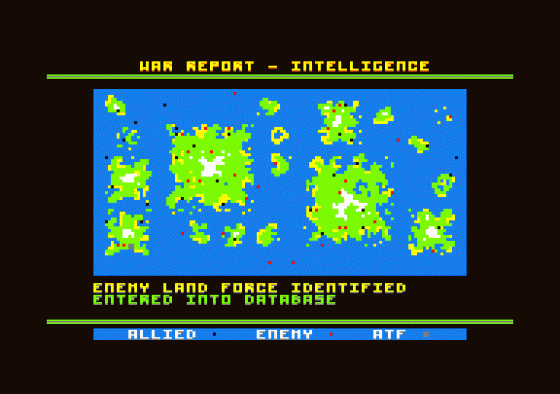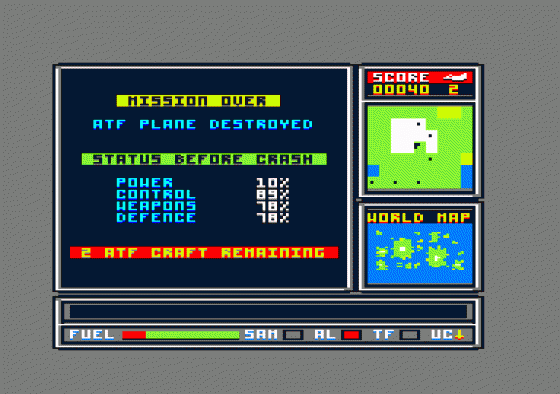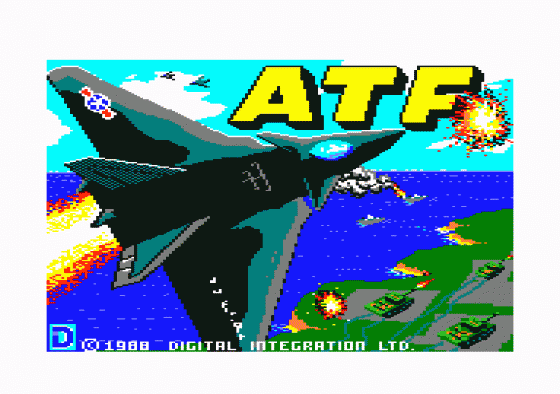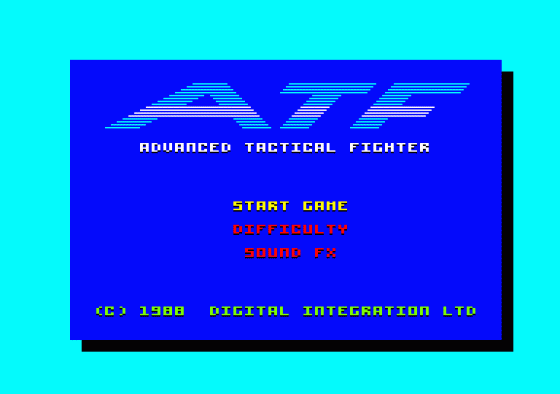
Amstrad Computer User
 1st May 1988
1st May 1988
Author: Lee Paddon
Publisher: Digital Integration
Machine: Amstrad CPC464
Published in Amstrad Computer User #42
ATF: Advanced Tactical Fighter
Lee Paddon, Technical Editor of Flight International and long time Amstrad fan, takes to the skies with DI's latest game
Digital Integration can hardly be considered the most prolific of software houses. Despite being around since the dawn of home computer history (way back in 1982) it has only produced a handful of games. But what games!
Over the years it has built up an excellent reputation in the heavyweight simulation scene. For this reason, ATF comes as a bit of a surprise. It is, at heart, an arcade game with a bit of strategy tacked on to it.

You control the ATF, an advanced, futuristic fighter. Your job is to help your side win the war. There are eight levels of difficulty, from rookie to ATF ace. This level determines how much damage each enemy hit does to the aircraft and the initial balance between good guys and bad guys.
Once the level has been selected, the program works out the scenario and displays the position of all enemy and friendly forces on a world map. This map is wrapped around, so to get to some parts of it, it can be quicker to go off one side and come on the other.
While on this map, you plan your sortie. You are given an intelligence report on the position of two enemy units which are loaded into your target database. All the other enemy units are shown as red blobs - you don't know what sort of unit they are, although if in the middle of the sea you can have a good guess.

The next screen is the war report which shows the number of units on each side, broken down into five types - bases, tanks, warships, communications bases and factories. You need at least one base to land, but destroying the enemy's doesn't seem to stem the tide of interceptors. However, if you damage a base, your side may capture it.
Tanks and warships govern where the war is won and lost. When all of one side's tanks and warships have been destroyed the game is over and the victory level assessed. Obviously, destroying these lessens the chance that they will destroy and capture your units. Communications bases coordinate forces, The more of these around, the more effective forces will be in capturing and destroying enemy units.
Factories and communications bases can also be damaged rather than destroyed to make them easier for your forces to capture.

The essential information to look for here is how the battle between the opposing land and naval forces is going. Can you afford the luxury of going for factories or bases, or must you try and stem the tide on land and sea?
Fuelled And Armed
Then it's on to the arming screen. The AIF carries 8000kg of stores. A full load of fuel is always a good idea, leaving you with 6000kg for weapons. Here comes the hard choice. Mavericks are convenient and potent weapons. Just fire and forget. But all that radar homing equipment makes them a bit heavy. These weigh in at 250kg a piece.
ASBAAMs (don't ask me what it stands for) only weigh 100kg but require guiding to the target. Lastly, there's a cannon for dealing with the hordes of interceptors that come your way. The mix of weapons is a matter of personal choice, but I found that if I loaded up with 15 Mavericks and five lots of cannon, it was usually sufficient.

Mavericks can be launched from about 80km from the target wrth the AIF going full tilt, jinking and weaving to avoid interceptors. Firing an ASRAAM on the other hand, means you have to slow down, get right on to the target's bearing, fly towards it and just as it pops over the horizon, fire the missile and guide it onto the target.
If the target isn't destroyed by the first missile, you've rarely got enough time to get off a second one so you've got to circle round and have another go.
With Mavericks, you've got plenty of time to get two or three missiles off at the target on one approach. ASRAAMs are hampered by interceptors turning up just as you're making your approach behind and above. The lower half of this area shows the undulating landscape criss-crossed by a grid of lines to give a feel of perspective.

The top part of the area shows the head-up display (HUD). This gives the throttle setting and speed (usually the same unless the undercarriage is down or the aircraft is accelerating or decelerating), heading, target data, weapons status, altitude and ground height.
To the right is the scanner showing nearby ground and air targets. Underneath is the computer, which has four modes - world map, database, stores and ATF status. The world map simply shows the aircraft's present position and the position of the selected target. This is useful for checking your progress against the route you planned using the map screen at the beginning.
The database gives the bearing and range of all friendly and enemy forces mentioned in intelligence reports or which have appeared on the scanner. You can select any enemy type and then either step through all the units in the database or simply select the nearest one. This information is then transferred to the target data section of the head up display.

You just line up the heading readout with the target, bearing, wait until you're within 80km of the target and let a Maverick fly. The "weapon ready" symbol will disappear from the HUD and will reappear when the missile hits. Or if you're feeling really brave, you can go in there with an ASRAAM and tough it out at point blank range.
The stores status gives the remaining amount of cannon ammunition and missiles, while the ATF status screen shows the amount of damage taken. This is usually more noticeable by the way the damage restricts the maximum throttle setting. If too much damage is caused, you cannot keep up your airspeed, so you stall and crash.
Underneath this is a message panel which tells you when new enemy forces have been located, the results of your missile launches and helpful bits of advice like reminding you to lower the undercarriage when coming in to land. Therefore when a message about new forces comes up, if you quickly hit the Return key its data is put into the target display and you can immediately loose off a missile at it, often without needing to turn or slow down.

The last panel, at the bottom of the screen, contains the fuel gauge and status lights showing if you're in terrain-following or auto mode, undercarriage position and SAM lock on. SAMs are a minor irritation. When the SAM light flashes and a warning bleeper sounds, you just hit the jammer.
Occasionally, you might get caught out in a moment of panic. This is bad news. SAMs always hit, and are always fatal. The other bane of your existence is interceptors. They either attack head-on or try and sneak up from behind. The head-on attacks are simple, just let fly with a few rounds as the enemy starts his approach.
Attacks from behind can be lethal. You must break hard away from the enemy as soon as he appears. Any delay and he sticks to your tail like glue, pumping cannon rounds into your craft. On higher levels, just one mistake can prove fatal. Eventually, a following enemy gets bored and turns away. Now's your chance to quickly change direction and open up before he can escape. The other option is to dodge. You don't get that many points for destroying them and it doesn't seem to make much difference to the number that attack.

Two rather neat high tech touches are the terrain following and automatic landing systems. Terrain following does just that, the aircraft climbs and dives in response to the hills and dales. This looks impressive, but is of limited practical value. The manual says that it reduces the number of SAMs that come at you, but I hardly noticed the difference.
The only thing to remember with this system is don't disengage it when in a dip, as you'll tend to fly straight into the nearest hill! The manual also recommends you to use it when at full speed, but I never had any trouble.
The landing system really takes all the hard work out of life. Let's face it, this is a shoot-'em-up, not some nasty complicated flight simulator. Once you are within about 80km of a base, the auto landing light starts to flash; you can then hit the land button and go away and make a cup of coffee while the ATF gets on with it. It also helps to stick the undercarriage down at this point.

Fortunately, the auto lander won't crash land you on the tarmac, but will carry on blithely flying in a straight line, presumably until you run out of fuel. This is quite a useful tactic for carefree travel to the battle zone. If your proposed target is quite some distance away it can be a pain constantly having to battle interceptors. So deliberately mess up your approach while facing the direction you want to go. Then carry on until you reach the target area, disengage auto land and carry on.
It's a pity that you have to use auto land. Any macho seat of the pants types will be disappointed if they try a manual approach - you just dig a neat hole in the ground.
Control is by joystick or keyboard, and the plane moves very smoothly as it banks left or right. There are only three positions for the aircraft, turning right, left or straight ahead.

The terrain scrolls smoothly without any sign of jerky movement even when there are several interceptors on the screen. At full speed, the effect of the ground flashing past beneath you is really satisfying. Speed freaks can turn off the lines, which speeds up the action.
Once on the ground, a war report is shown. The first bit gives an analysis of your performance. It shows the number of targets you destroyed, including friendly forces for those who want to be popular with the General Staff, along with the number of interceptors downed. This is compared with the amount of damage taken during the sortie to give an assessment of your performance.
Then the report goes on to show the change in the strategic situation with the gains and losses for each side. Gains will include new units provuded and enemy units captured.

Losses will show any units captured or destroyed by ground forces or your ATF. Then it is back to the intelligence screen, war report and arming screens.
The game ends when either all three of ATF's have been lost or one side has lost all its land and naval forces.
Altogether this is very slick, well produced and presented. Obviously there is a chance that the game will fall between two stools. It may be dismissed by the shoot-em-up fraternity as too complex and yet harangued by the flight simulator aficionado as being too simple.
There are sixteen control keys plus a joystick. At least half a dozen of these are in pretty constant use. It is rare for a shoot-'em-up to allow itself more than a couple of keys over and above the joystick. An certainly makes no pretence to be a flight simulator. It sacrifices all subtlety for speed and smoothness. There is certainly plenty of that with very smooth animation and graphic detail,
But if you are patient enough to master the complexities of the button infested keyboard and are a bit browned off with the up/down scrolling blaze away type of game, this could be a welcome change.
The strategy element is well thought out and works well. It doesn't pay to expend all your ammunition on a recalcitrant enemy base while ranks of his tanks and warships run riot. Ruthlessness, daring and fast reflexes are blended with thoughtful planning and an ability to recognise when discretion is the better part of valour - you run away.
The Advanced Tactical Fighter
The good thing about producing a game based on the Advanced Tactical Fighter is that no one can accuse you of inaccuracies. The plane has not made it off the drawing board yet.
At the moment Lockheed is in competition with Northrop to build a prototype. These will be flight tested by the end of the decade. One version will then be chosen by 1991 for full scale development.
Alongside this is a competition pitting Pratt and Whitney against General Electric for the engine. So there will be four prototypes giving all permutations of airframe and engine.
A good deal rides on the ATF. Despite the present climate of budget cutbacks, the project seems certain to go through. By the time production starts in the late '90s there is no knowing what the Russians may have come up with.
Superior Design
The US has been badly shaken by the excellence of recent Soviet designs including the Flanker and Fulcrum. By the late '90s the Flit will be nearly 25 years old and even the F18 Hornet will be a bit long in the tooth. The F20 Tigershark programme was recently cancelled.
The ATF specification calls for a small "cheap" fighter costing less than $36 million apiece. This has already led to design problems with thrust reversers for short landing going out the window.
Speculation is that the plane will be highly agile with many parts made of composite materials such as carbon fibre. As much stealth will be built in as possible, along with multi-function radar. Basically it has got to be able to see and destroy the enemy before the enemy does the same to it.
Digital Integration has a record for innovation and technical excellence that is second to none.
Formed in 1982 by Dave Marshall and Rod Swift, it quickly established its pedigree with Night Gunner, a multi-level shoot-em-up with outstanding graphics and gameplay. Next zame Fighter Pilot which seemed to hang around in the charts for ever [Deservedly so - Ed]. While others were content to call anything with a few instruments and a bit of graphics a flight simulator, DI put in realistic performance and absorbing strategy.
Then, somewhat later than promised Tomahawk was released. This built on Fighter Pilot by adding a lot of ground detail and gameplay as you slugged it out with ground targets and helicopters. It was the first really plausible helicopter simulator, and set new standards in what people expected from simulators,
You didn't just simulate any aircraft, you included the characteristics of a particular craft. You didn't play in isolation, you had missions to perform. DI ended up with a rattling good game.
Then another rather overdue product arrived in the form of TT Racer. Winner of the "coming soon" prize two years running, it was one of Digital's less well received games; it nevertheless led to the recently released Bobsleigh, where Rod Swift's screen swivelling banking effect seemed more at home.
The company has been expanded slowly over the years. The team is presently working on Fighting Falcon over several formats which Dave Marshall promises is going to be their best yet. This represents a return to the old stamping ground of full blown flight simulators.
Dave Marshall used to be involved with the design of "real" flight simulators for the Royal Aircraft Establishment, this not only means he knows a thing or two about aircraft, he still has plenty of friends in the industry.
His research for the latest game includes pilfering press releases from Flight magazine and popping off to have a go on a professional F-16 simulator just to make sure he hasn't missed anything.



